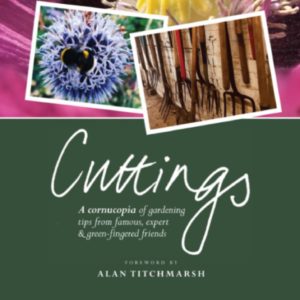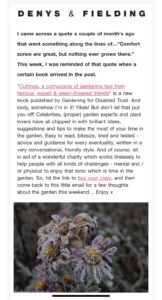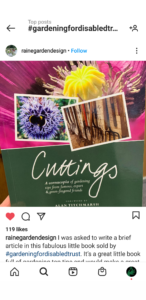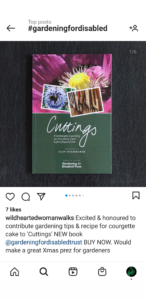Keeping Gardeners Growing
by Heather Fooks a long- standing member of Gardening for Disabled Trust Charity Committee. December 2020.
Here we are, finding ourselves in the last month of the year. The
shortest days are on us and darkness descends soon after four o’clock.
A few strong gales have swept many of the leaves from the trees and
spread their luxurious golden colours over our lawns, in our ditches and
our flower beds , beneath the trees and, even, if we’re careless enough
to leave our doors open for short while , inside our homes!! Only the
oaks, the last bastions of these golden colours, cling on stubbornly to
their leaves, until the next storm tears them out completely and they too
bow to nature and fall to join their fellows.
Now is the time when evergreens have their day. Without their solid
shade of green, their shelter and, above all, their shape, their statement
of space, contour and structure, the winter garden would lose much of
its character.
Those of us who live in a rural area know that winter, as well as spring
has its own characteristic beauty. The trees , stripped of autumn
brilliance have their own beauty. Unclothed, we can see their true
individual forms, as their dark tracery stands out against the sky.
Many people ‘fidget ‘ (William Robinson’s description, not mine!!) at the
sight of beautiful leaves in autumn. Instead of enjoying them, as Shelley
did. They rush to sweep them up whilst there are still many left to fall
down. The invention of the ‘garden blower’ has revolutionised the job !
Using this device, we leave the clearing until all the trees are bare, blow
them into manageable heaps, load them on the trailer, and deposit them
in a place set aside for leaf mould, where they remain for three years,
and used therefore in rotation. Any that have fallen amongst trees or
shrubs, we leave to slowly enrich the soil as they decay.
There are plants to enjoy in these seemingly “barren ‘ months of winter.
Shrubs such as the wintersweet Chimonanthus praecox. The winter
honeysuckle Lonicera fragrantissima, witch hazels, Daphnes and azaras
are all easy to grow. The winter iris I.ungulates (stylosa) has been
flowering for some time now. It loves to be in poor soil against a wall in
full sun. This hot summer has encouraged it to flower earlier than usual,
which I think is why we’ve been enjoying them for some weeks. We
must not forget Helleborus niger, the Christmas rose. In High Dutch its
called Christ’s herb, ‘because it flowereth about the birth of our Lord’ .
They like a rather moist, semi-shady place in rich soil.
One of the brightest highlights in a winter garden can be Cyclamen
coum. In the right position, this bright, hardy cyclamen can delight us
with magenta, pink or white flowers from now through to spring. Their
round or slightly heart-shaped leaves begin tho grow in late summer
and autumn. They exhibit a huge range of colour, pattern , and designs.
They grow from underground tubers that go dormant in early summer ,
starting back into growth again in late summer. We grow them in
borders that are usually moist, under trees and shrubs, where they
appear to be happy and are seeding enthusiastically.
Christmas is looming and under the present uncertainties, our
celebrations may be seriously curtailed. Whenever world events alarm
us and life becomes uncertain, gardeners should take comfort in
Voltaire’s words: ‘il faut cultiver notre jardin’. Literally translated that
means ‘We must cultivate our garden”. He wrote this in a famous novel
called “Candide” which he was writing during the ‘Seven Years’ War.
This was a very nasty Europe-wide conflict. Things may be bad for us at
the moment , but, hopefully, they are not THAT bad!
What Voltaire was getting at was, that when confronted with un-looked
for national or world disasters, the best thing we can do is to deal, in
our personal way, with the things that really matter and that we CAN do
something about. So, whatever you do in the garden this winter, I hope
you enjoy those days of cold but crisp sunny weather, the changing
views and colours of our borders and the fun of looking ahead and
planning for next year.
May I wish you a Healthy and Happy Christmas from Heather
************************************************
This year was a strange year, like so many charities we plan to hold various fundraising events throughout the year. With Covid it meant we were unable to organise them. Instead of the committee meetings being held at a kitchen table we were transported to virtual meetings and then Rosie on the committee suggested putting together a book of gardening tips to raise funds and suddenly we were all galvanised into action and a germ of an idea snowballed and now in December we are on our second print run and we have learned how to pack and post under tier 4 restrictions!! Its a shame we haven’t been able to share the excitement as a committee and trustees together but we are all pleased with how our book has been received and overwhelmed by people donating their gardening tips and then helping to promote it.

Our book is simply called ‘Cuttings – A Cornucopia of Gardening Tips from Famous, Expert and Green-fingered Friends’. The foreword is by Alan Titchmarsh our President and with contributions from Julian Clary, Carol Klein, Mark Lane, Joanna Lumley, Dame Helen Mirren and many others. It was great to receive tips from supporters who recognise the benefit of gardening to both our mental and physical wellbeing. This year like no other has taught so many of us how valuable our gardens are. The range of tips on offer in our book is incredible and encompasses a wide spectrum of horticultural subjects.
We were so pleased that Mark Lane, one our Trustees offered to launch our book for us https://youtu.be/tkaKuGcXpSg please click on the link to hear Mark Lane talk about ‘Cuttings’.
Once launched the book has stood up to scrutiny and so many people have offered to help promote the book. Gardening for Disabled Trust works on a shoestring budget – we give out something in the region of £50,000 a year in grants but the charity is run by volunteers who give up their time and as a result our running costs are less than £2000 annually which is mainly spent on insurance, postage and printing.
If people promote our book on social media Gardening for Disabled Trust Charity is able to use the money on grants to get people gardening again rather than advertising. We really can’t thank our loyal supporters enough, they really help us to promote the book and avoid advertising costs.

Thank you Melanie Reid for mentioning us in her column in The Times

Thank you Helen Yemm for mentioning us in your column in The Telegraph

Thank you James Fisher for mentioning us in Country Life Magazine
On Social Media we now have over 2800 followers on Twitter and we have been followed by BBC Gardeners World which has over 98,000 followers. If you want to follow us we are @Garden4Disabled. We have been in existence for over 50 years and we are really beginning to be noticed as the only charity in this field and the vital importance of the work we do.
We have super supporters on Social Media worldwide who really help us to get our message out there, here are a few of their lovely tweets about ‘Cuttings’




On Instagram we are @gardeningfordisabledtrust and have about 500 followers
Here are few examples of lovely posts we have had on Instagram about ‘Cuttings’


Finally we also have a page on Facebook so please join us on Social media and keep up to date with our activities and how you can support us.
Thank you again to everyone who donated their gardening tips and helped us make a success of ‘Cuttings’ to date we have sold over 1700 copies








 Mike Higgins is a Chartered Horticulturist and Chartered Environmentalist working as a Tree and Landscape Officer at Pembrokeshire Coast National Park Authority and Tree Consultant at Brecon Beacons National Park Authority. He is also involved with The Tree Council and Arboricultural Association, coordinates a volunteer tree warden scheme in Pembrokeshire and is a keen amateur photographer.
Mike Higgins is a Chartered Horticulturist and Chartered Environmentalist working as a Tree and Landscape Officer at Pembrokeshire Coast National Park Authority and Tree Consultant at Brecon Beacons National Park Authority. He is also involved with The Tree Council and Arboricultural Association, coordinates a volunteer tree warden scheme in Pembrokeshire and is a keen amateur photographer.





























 In 2014/15 I became seriously ill and I spent the whole of 2015 in hospital. This experience left me disabled using a wheelchair and stairlift etc.
In 2014/15 I became seriously ill and I spent the whole of 2015 in hospital. This experience left me disabled using a wheelchair and stairlift etc.














